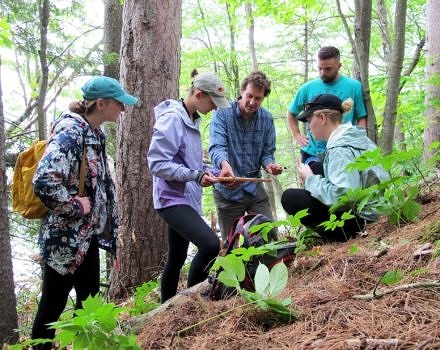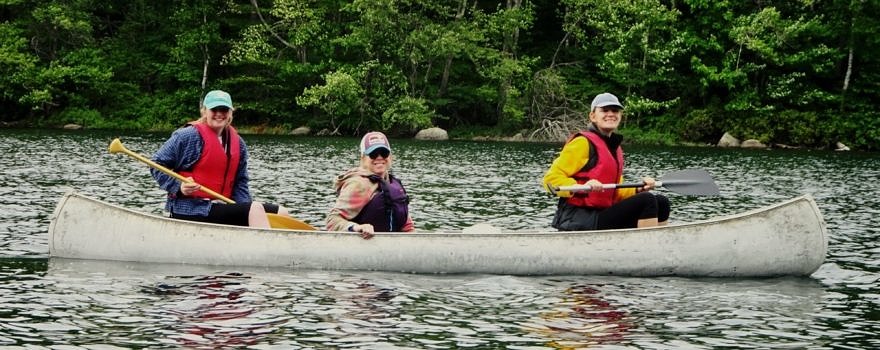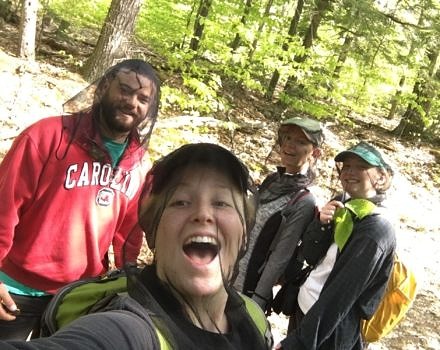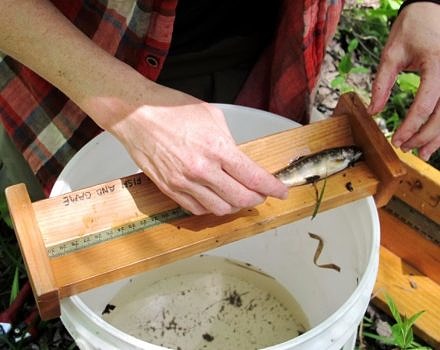Last week, we wrapped up our sixth year of the Harris Center-Keene State College conservation internship program, a two-month summer internship experience for undergraduate students in the Environmental Studies Department at KSC.
Under the guidance of Harris Center staff and KSC professor Karen Seaver, a team of four fantastic undergraduate interns − Emma Coffey, Audrey Kaiser, Lauren Peyser, and Taylor White − assisted with many facets of the Harris Center’s diverse conservation work.
Harris Center Executive Director Jeremy Wilson trains the KSC internship team on how to sample and preserve tree cores for a dendrochronology study of Norway Pond. (photo © Brett Amy Thelen)

KSC conservation intern Audrey Kaiser uses a depth rod to measure water depth at a road-stream crossing. (photo © Brett Amy Thelen)

KSC conservation interns Lauren Peyser (left) and Audrey Kaiser (right) paddle with KSC faculty supervisor Karen Seaver (middle) to Harris Center-protected land on the shoreline of Nubanusit Lake. Note the smiles -- this photo was taken before discovering the dead eagle chicks!

Bug nets are an essential piece of field gear for long days in the field! (photo © Emma Coffey)

A Trout Unlimited biologist measures the length of an Eastern brook trout during a post-restoration fish survey of Falls Brook. The KSC internship team helped retrieve fish from, and return them to, the brook during this study. (photo © Brett Amy Thelen)

A Diverse, Hands-on Introduction to the Conservation Field
Together, the team collected 34 tree core samples, surveyed 23 forest community inventory plots, documented 20 new vernal pools, collected data on 13 road-stream crossings, measured and monitored 7 American chestnut seedlings, surveyed 6 redbacked salamander research plots, monitored 2 conservation easements, pulled hundreds of invasive plants, planted and watered scores of native plants at a stream restoration site, worked on several Harris Center trails, and assisted with educational events, among other tasks.
Their most memorable task was also the most unpredictable one: retrieving and transporting not one, but two dead Bald Eagle chicks — two weeks apart — from Lake Nubanusit, via canoe and car, to the Wings of Dawn Wildlife Rehabilitation Center to be necropsied. As Audrey reflected, “There is something about removing, carrying, and smelling a dead animal that in life is regarded with importance and respect that really changes a person…It made me realize that the field I want to go into isn’t always about pretty plants and comfortable situations. This kind of work requires an ability to be prepared, keep a level head, and sometimes a strong stomach.”
As the internship drew to a close, all four members of the team expressed a deep appreciation for their experience with the Harris Center. For Taylor, the internship “allowed me to see how my studies at Keene State can translate into real work and how that work can directly impact the environment.”
“The Harris Center internship was a phenomenal learning opportunity,” said Audrey. “It gave me vital tools to understand, communicate, and carry out scientific work.”

